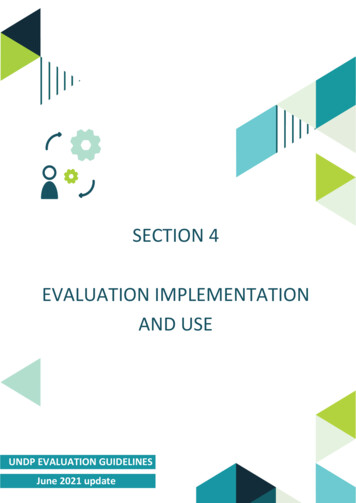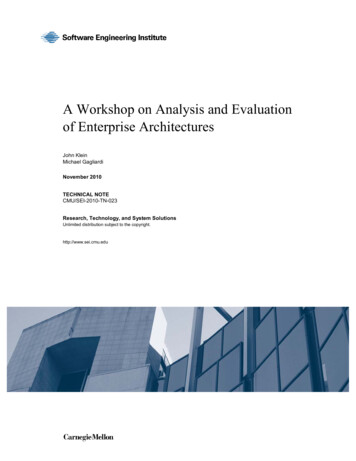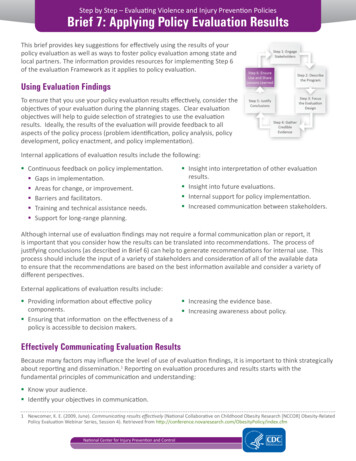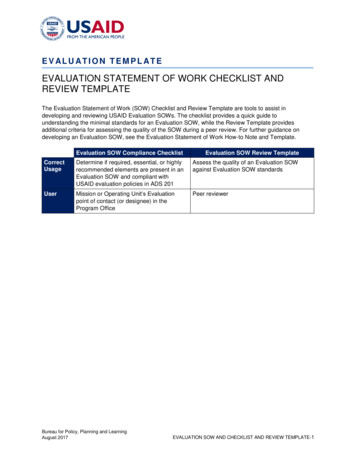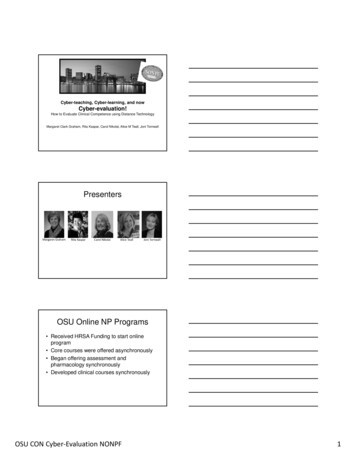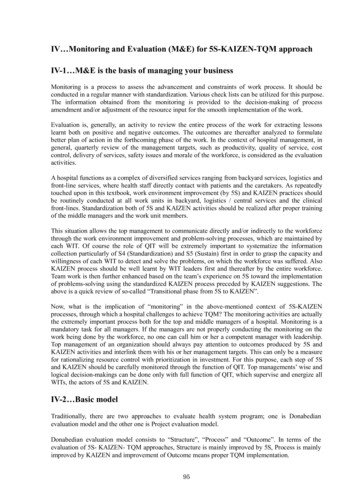
Transcription
Running Head: CLINICAL JUDGMENT IN NURSING STUDENTS1An Evaluation and Comparison of Clinical Judgmentin Junior and Senior Nursing StudentsCorrine StoneAn Honors Thesis Presented in Partial Fulfillment of the Requirements for the Degree ofBachelor of Science in Nursing with DistinctionThe Ohio State University College of NursingHonors Thesis CommitteeEsther Chipps PhD, RN, AdvisorCelia E. Wills PhD, RN
CLINICAL JUDGMENT IN NURSING STUDENTS2AbstractWhile the majority of nursing research about clinical judgment has focused on thedecision- ‐making of experienced RNs, there is a scarcity of current research available on thedevelopment of clinical judgment in student nurses. Little is known about when clinicaljudgment begins and how clinical judgment develops throughout the course of education. Inorder to understand whether student nurses are equipped to participate in error mitigation wemust begin with an empirically based understanding of how student nurses judge and classifyerrors. The specific aims of this study were to: (1) determine if nursing students judgmentsabout errors (severity, level of risk, and contributing risk factors) changes after a year of clinicalexperience; and, (2) explore the perception of student nurses regarding promotion of safeenvironments and their perceived ability to participate in risk reduction and error mitigationpractices in the clinical setting. The sample (n 43) consisted of junior (65.1%) and senior(34.9%) students of a baccalaureate- ‐nursing program at a large Midwestern university. A crosssectional descriptive survey design was used in which each participant was given an envelopewith a questionnaire presenting four clinical scenarios with instructions to: (1) rate the severityof the error (2) rate the perceived risk of the error and (3) identify potential contributing factorsleading to the error. Descriptive and correlational analyses were used to summarize andcompare responses. Across the four vignettes judgments about error classification were highlyvariable. There were differences between juniors and seniors in the severity of classification ofthe clinical errors and the probabilities that these errors occur. The results of this study havethe potential to contribute valuable insight into the development of clinical judgment over time
CLINICAL JUDGMENT IN NURSING STUDENTS3in student nurses, and can indirectly shed light upon the clinical judgment of new graduatenurses entering practice.
CLINICAL JUDGMENT IN NURSING STUDENTS4Chapter I: Literature ReviewThe majority of nursing research about clinical judgment has focused on the decision- ‐making of experienced RNs. By contrast, there is a scarcity of current research available on thedevelopment of clinical judgment in student nurses. Newly licensed graduates representapproximately 10% of the current nursing staff, with this 10% being relatively inexperiencedwhen compared to the whole (Berkow & Verkstis 2008). Undergraduate nursing programsprovide skills and competencies built on the foundations of pathophysiology, human bioscience,and nursing theory and utilize clinical internship/residency, and simulations in order to preparestudents for professional practice. Little is known about if these efforts foster clinical judgmentin student nurses, when clinical judgment begins, and how clinical judgment is developedthroughout the course of education.Students are transitioning into the RN role unaware of the high level of critical thinkingand decision making that will be required of them as RNs in order to respond to acute clinicalscenarios and participate in error mitigation (Etheridge 2007). In a recent study examining thecritical thinking abilities of new graduate nurses 25% of new graduate nurses did not meetexpectations in regard to independent nursing interventions (97.2%), differentiation of urgency(67%), reporting essential clinical data (65.4%), anticipating relevant medical orders (62.8%),providing relevant rationale to support decisions (62.6%) and problem recognition (57.1%) – allof which rely upon critical thinking abilities (Fero, Witsberger, Wesmiller, Zullo & Hoffman,2008). In 2006 The National Council of State Boards of Nursing published a research brief ontransition to practice for new graduate nurses – which exhibits the reality of this gap in newgraduate critical thinking. When asked if they had ever been involved in actual errors or
CLINICAL JUDGMENT IN NURSING STUDENTS5potential errors, 53% of the nurses indicated that they had either made errors themselves,supervised others making errors, or had been the one to discover errors made by others(Kenward & Zhong, 2006).An integrative review of over 75 articles related to novice nurse error and clinicaldecision making identified, “critical thinking and experience [as] common themes in most of theerrors evaluated” (p. 358) in their review of novice nurse errors. Employers recognize this gapin new graduate nurse ability (Saintsing, Gibson, and Pennington, 2011). In a national survey ofemployers (including hospitals, home health agencies, and nursing homes) less than 50% of theemployers reported new graduate nurses as being prepared to provide safe and effective care(Smith and Crawford, 2004). This is a very concerning and undesirable finding, as nursingdemands a high level of cognitive ability and advanced decision making skills in order topromote patient safety.The WHO’s World Alliance for Patient Safety identifies patient safety as a key concept ofrelevance in its International Patient Safety Classification (ISPC) system. The aim of patientsafety practice, as outlined by ISPC, is to “[reduce the] risk of unnecessary harm associatedwith healthcare to an acceptable minimum” (Runciman, Hibbert, Thomson, Van der Schaaf,Sherman & Lewalle, 2009). Upon graduation student nurses will be expected to promote safetypractices and participate in error mitigation through clinical judgment in risk assessment,enabling them to identify, prevent, and subsequently, reduce the occurrence of medical errorsand promote patient safety (Rogers et al., 2008; Jeffs et al., 2009).
CLINICAL JUDGMENT IN NURSING STUDENTS6In January 2014 Tella et al. (2014) published an integrative literature review of twentystudies appraising the content of patient safety in pre- ‐licensure nursing curricula. Patient safetywas identified within curricula related to learning from errors, individual and inter- ‐professionalteamwork, anticipatory action in complex environments, and patient- ‐safety centered nursing.In addition to the material presented in an academic setting, patient safety was also identifiedwithin inter- ‐professional simulation scenarios, using critical thinking checklists, and practicewith web- ‐based hazard and near miss reporting systems in clinical. Following comprehensivereview of these twenty studies Tella et al. (2014) concluded that “if patient safety was notevident as a subject in the nursing curricula but rather integrated in several modules, it coulddisappear” (p. 10). Furthermore, Tella et al. (2014) concluded that formal education does notguarantee that students improve in their understanding of patient safety. However, in theirconcluding discussion Tella et al. (2014) recognize the important role curricula plays indemonstrating patient safety principles and practices. They recommend that patient safetycontent within pre- ‐licensure program’s curricula is “clear and explicit” and that patient safetycontent is incorporated into both academic settings and clinical practice settings (Tella, Liukka,Jamookeeah, Smith, Partanen & Turunen, 2014).A study of clinical decision making during the transition from student to RN concludedthat clinical decision making skills need to be taught in pre- ‐licensure courses in the classroomand clinical (Standing, 2007), giving further support to Tella et al.’s findings. The prescriptivedecision making model in nursing, endorsed by the American Nurses Association (ANA), is thenursing process – assess, diagnose, outcomes/planning, intervention, and evaluation(International Council of Nurses, 2005). Every nursing student knows and uses the nursing
CLINICAL JUDGMENT IN NURSING STUDENTS7process in planning patient care, but its applicability with unexpected decisions is debated,being criticized for being too systematic (Standing, 2007). Unfortunately, there is currently alack of evidence for how to design a curriculum and foster a learning environment that aids indeveloping clinical judgment largely because the process of how students learn to make clinicaljudgments is not fully understood (Bowles, 2000; Grealish, 2000). While cognitive ability andacademic success seem to be positive indicators, excellent students do not always developexcellent clinical judgment (Botti & Reeve, 2003). A study on students in their final year ofnursing school suggests additional factors seem to be required in fostering clinical judgment.Results of a self- ‐assessment questionnaire exploring personal confidence and understanding ofclinical decision- ‐making demonstrated that most students believe that experience was a helpfulfactor in learning decision- ‐making skills. However, the same study found only limited evidencelinking the application of decision- ‐making theory to practice. Instead, the study’s findingssuggest that the majority of student nurses view clinical judgment in terms of applying fixeddecision making pathways or templates based on prior experience (Garrett, 2005).Numerous studies have been conducted over the last ten years exploring the perceivedcompetence of graduating student nurses. When exploring the perception of final year nursingstudents at an Irish university, Doody et al. (2012) found that 53% of respondents reportedthemselves to be adequately prepared to take on the role of an RN, 31% were neutral towardstheir level of preparation, and 16% disagreed that they were prepared to transition to being anRN. This study also evaluated the student’s perception of course relevance in relation to thetransition to being an RN – 62% of respondents agreed that course content was relevant to thistransition, while 19% were neutral and 17% disagreed. In Lofmark et al.’s (2006) study of self- ‐
CLINICAL JUDGMENT IN NURSING STUDENTS8perceived competence in final year nursing students, the highest level of competency reportedby students was in ethical awareness and patient communication and interaction (2006).Hengstberger- ‐Sims et al. (2008) had newly graduated nurses complete a questionnaire thatused the 2001 Australian Nurse Competency Standards, the Nurse Competency Scale, andVisual Analogues to self assess perceived competency and the frequency with which theseareas are engaged. Planning and making decision related to patient care were identified amongthe lowest level of competency in newly graduated student nurses (2008). Wangensteen et al.(2012) also used the Nurse Competency Scale to assess newly graduated nurses self- ‐perceivedcompetence and found ensuring quality patient care as a lower area of competence. Thefindings of these studies are rather disturbing as they imply that students recognize their ownincompetence in critical thinking and decision making in regards to planning and providing safeand quality patient care. This may be due to students underestimating the preparation neededto independently take on the RN’s role (Newton and McKenna, 2007) or it could be a result ofgaps in pre- ‐licensure curricula as suggested by Tella et al. (2014). In order to understandwhether student nurses are equipped to participate in error mitigation and promote patientsafety we must begin with an empirically based understanding of how student nurses judge andclassify errors. The aim of this study is to: (1) determine if nursing students judgments abouterrors (severity, level of risk, and contributing risk factors) changes after a year of clinicalexperience; and, (2) explore the perception of student nurses regarding promoting safeenvironments and their perceived ability to participate in risk reduction and error mitigationpractices in the clinical setting.
CLINICAL JUDGMENT IN NURSING STUDENTS9Chapter II: MethodsDesignA descriptive cross- ‐sectional survey design was used in which junior and senior levelnursing students completed a questionnaire on perceived judgment of the classification andrisk level of patient care errors.SettingThis study took place at a large Midwestern University College of Nursing.SampleA convenience sample of junior and senior students was recruited from a baccalaureate- ‐nursing program at a large Midwestern university. A total of 15 juniors and 28 seniors werecompleted the questionnaire. Participants were recruited on a voluntary basis through visitingfive lectures over the course of one semester and explaining the aims of the study and whatparticipation would entail.Data Collection ProcedureApproval for all study procedures was received from the university Institutional ReviewBoard prior to data collection. Surveys were distributed in envelopes prior to junior and seniorlevel lectures. Students were instructed to return the surveys in a sealed envelope within threeweeks to a designated sealed collection box in the lobby of the College of Nursing.InstrumentA previously- ‐developed validated questionnaire was used in this study (Chipps, Wills,
CLINICAL JUDGMENT IN NURSING STUDENTS10Tanda, Patterson, Elfrink, Brodnik, Schweikhart & Ryan- ‐Wenger, 2011). The questionnairepresents four clinical vignettes that the students will read and were then instructed to: (1) ratethe severity of the error (2) rate the perceived risk of the error and (3) identify potentialcontributing factors leading to the error. These vignettes were created from actual errorsidentified during in- ‐depth individual interviews and focus groups conducted with experiencedpracticing nurses (Chipps, Wills, Tanda, et al., 2011). Each vignette describes a complex clinicalsituation in which an error is made by an acute care RN. These vignettes have been confirmedas complex clinical situations based on the review and analysis of content experts. Eachvignette was followed by a perceived error severity scale, perceived probability of error scale,and perceived contributing factors (see Appendix A).Perceived error severityIn 1996 the National Coordinating Council for Medication Error and Reporting andPrevention (NNC MERP) index was developed in an effort to establish a taxonomy formedication error classification. Numerous hospital based risk management programs useadaptions of this scale. The index is made up of nine categories that describe error severity andthe level of harm associated with said error. The index begins with no error (level A), increasesto error, no harm (levels B- ‐D), then to error, harm (levels E- ‐H) and ends with death (level I). Foreach vignette the participant was asked to classify nursing care error severity using the NCCMERP error classification index.Perceived probability of errorIn order to assess the perceived risk of the error a risk assessment scale was adapted
CLINICAL JUDGMENT IN NURSING STUDENTS11from Resource Engineering Inc. for use in the questionnaire. This risk assessment scale is basedupon principles of failure mode and effects analysis and assigns increasing levels of risk from 1to 7, with 1 being the lowest probability of risk and 7 being a certain probability of risk.Participants rated the probability of the event in each vignette occurring in the practice settingusing this scale.Perceived contributing factorsThe prior research compiled a list of potential contributing factors leading to errorsbased upon a theoretical framework on human factors – resulting in 15 final factors. These 15factors were divided into the following three categories by content experts: (1) nurses’knowledge and experience, (2) nurses’ clinical practice, and (3) work environment. For eachvignette participants reviewed all 15 factors and checked the factors they believed contributedto the error.Additional data were collected (8 items) on individual characteristics of the participantsincluding other degrees or areas of study, current employment status during school (position,job title, setting, and number of hours per week), current clinical experience, previous clinicalexperience, and experience using the event reporting system.Data AnalysisBecause there were small response frequencies for some categories of the NCC MERPindex and risk occurrence scales used by the respondents, the scales were collapsed. The NCCMERP categories were reduced from 9 to 4 categories including (1) Error, No Harm (B- ‐C); (2)
CLINICAL JUDGMENT IN NURSING STUDENTS12Error, No Harm, Required Monitoring (D); (3) Error, Temporary Harm (E- ‐F); and (4) Error,Permanent Harm (H- ‐I). The risk occurrence scale was reduced from 7 to 3 categories including(1) low probability of risk that either never occurs or occurs once per year; (2) moderate risk inwhich chances of occurrence are from once per 3 months to once per month; and (3) high riskin which chances of occurrence are once per week or more.Each vignette was analyzed using descriptive statistics to calculate the frequency of theratings for each scale and contributing factors. Chi- ‐square analysis was used to test for thepresence of statistically significant differences in questionnaire ratings between junior andsenior nursing students.
CLINICAL JUDGMENT IN NURSING STUDENTS13Chapter III: Results33 juniors and 42 seniors were offered participation. Of the 75 students invited tocomplete the questionnaire, a total of 43 students actually completed the questionnaire (45.5%juniors and 66.7% seniors), yielding a response rate of 55.1%. A demographic profile of therespondents is summarized in Table 1.Table 1Demographic ProfileSample Demographics (n 43)Grad DateOther DegreeCurrently Employed in HealthCarePast Health Care EmploymentClinical Patient PopulationMed/SurgWomens Health/PedsCritical CarePsychCommunityOtherSpring 2013Winter 2014Spring 201465.1% (28)2.3% (1)32.6% (14)YesNo9.3% (4)90.7% (39)88.4% (38)11.6% (5)2.3% (1)97.7% (42)Current Clinical RotationCompleted Clinical Rotation18.6% (8)100% (43)27.9% (12)93% (40)25.6% (11)74.4% (32)7% (3)65.1% (28)16.3% (7)65.1% (28)4.7% (2)Results for each vignette were analyzed individually. Results are organized by vignettewith a discussion of the overall results following the vignette.Vignette 1Vignette 1 describes an incident where a nurse who is caring for a tracheostomy patientis called away to care for a coding patient, during which time the RN forgets to put thetracheostomy patient back on the pulse oximeter. An hour later the tracheostomy patient is
CLINICAL JUDGMENT IN NURSING STUDENTS14found unresponsive, a code is called, resulting in the patient needing to be transferred forfurther care in the intensive care unit. Table 2 illustrates the responses for Vignette 1.Table 2Vignette 1Error Classification andRisk LevelError ClassificationError, no harmError, monitoringError, temporary harmError, permanent harmRisk LevelLowModerateHighVignette 1Juniors0 (0%)0 (0%)4 (26.7%)11 (73.3%)1 (6.7%)11 (73.3%)3 (20.0%)Seniors0 (0%)0 (0%)2 (7.1%)26 (92.9%)2 (7.1%)26 (92.9%)0 (0%)X2 3.1, p .08X2 6.0, p 0.05While this vignette did not yield any statistically significant results (X2 3.1, p .08) whencomparing junior and senior nursing students’ assessment of the error classification, it did yieldsignificant results (X2 6.0, p 0.05) in risk level. Twenty- ‐six (92.9%) of the senior studentsbelieve this error has a moderate probability of occurrence, and 2 (7.1%) seniors believe thereis a low probability of occurrence. However, data collected from the junior students does notshow such a high level of consensus on the moderate probability of occurrence. Eleven (73.3%)of the juniors believe that there is a moderate probability of occurrence, 3 (20%) believe thereis a high probability of occurrence, and 1 (6.7%) believes there is a low probability of occurrence.
CLINICAL JUDGMENT IN NURSING STUDENTS15Vignette 2Vignette 2 describes a nurse who is new to the unit and has to collect potassium levelson 2 patients. She places both patient labels in her pocket, collects the labs at bedside, butneglects to double check the labels with her patients’ identification bands and mislabels thespecimens. As a result, the patient with a normal potassium level receives an un- ‐necessaryreplacement dose of potassium. By the next day both patients’ potassium levels return tonormal. Table 2 illustrates the responses for Vignette 2.Table 3Vignette 2Error Classification andRisk LevelError ClassificationError, no harmError, monitoringError, temporary harmError, permanent harmRisk LevelLowModerateHighVignette 2Juniors0 (0%)9 (60%)2 (13.3%)4 (26.7%)1 (6.7%)14 (93.3%)0 (0%)Seniors0 (0%)18 (64.3%)9 (32.1%)1 (3.6%)6 (21.4%)21 (75%)1 (3.6%)X2 5.9, p 0.05X2 2.2, p 0.33Although comparison of junior and senior students in this vignette did not demonstrateany significant difference (X2 2.2, p 0.33) in risk level, the results for error classification didyield a significant result (X2 5.9, p 0.05). Nearly the same percent of junior (60.0%) and senior(64.3%) students thought believed no harm occurred, but that the patient would requiremonitoring. The remaining juniors and seniors did not agree on the level of harm. Nine (32.1%)
CLINICAL JUDGMENT IN NURSING STUDENTS16of the seniors believed there was temporary harm to the patient and 1 (3.6%) of the seniorsbelieve there was permanent harm done.Vignette 3Vignette 3 describes a charge nurse who is working with two patients with very similarnames in a gastroenterology procedure area. The charge nurse confuses the two patients’names and the patient in need of an emergent procedure is not treated, resulting in a fluidresuscitation effort. Table 4 illustrates the responses for Vignette 3.Table 4Vignette 3Error Classification andRisk LevelError ClassificationError, no harmError, monitoringError, temporary harmError, permanent harmRisk LevelLowModerateHighVignette 3Juniors1 (6.7%)1 (6.7%)8 (53.3%)5 (33.3%)3 (20%)12 (80%)0 (0%)Seniors0 (0%)2 (7.1%)18 (64.3%)8 (28.6%)14 (50%)14 (50%)0 (0%)X2 2.1, p 0.54X2 3.7, p 0.06Results for error classification in this vignette were not significantly different betweenjunior and senior students (X2 2.1, p 0.54), perceived risk level was found to be nearingstatistical significance (X2 3.7, p 0.06). Of the juniors, 12 (80%) believed that there was amoderate probability of error occurrence and 3 (20%) believe that there is a low probability ofoccurrence. However, the seniors were split with 14 (50%) that believed there was a low
CLINICAL JUDGMENT IN NURSING STUDENTS17probability of occurrence and 14 (50%) that believed there was a moderate probability ofoccurrence.Vignette 4Vignette 4 involves a new graduate nurse who gives a patient’s insulin two hours lateand forgets to mention this in report to the oncoming nurse. As a result, the oncoming nursegives an extra dose of fast- ‐acting insulin to cover a higher than expected blood sugar level. Thisextra dose of insulin results in a hypoglycemic episode that is treated. Table 5 illustrates theresponses for Vignette 4.Table 5Vignette 4Error Classification andRisk LevelError ClassificationError, no harmError, monitoringError, temporary harmError, permanent harmRisk LevelLowModerateHighVignette 4Juniors0 (0%)0 (0%)11 (73.3%)4 (26.7%)1 (6.7%)13 (86.7%)1 (6.7%)Seniors0 (0%)3 (10.7%)18 (64.3%)7 (25%)3 (10.7%)24 (85.7%)1 (3.6%)X2 1.7, p 0.42X2 0.4, p 0.83Results of this vignette comparing junior and senior students in error classification(X2 1.7, p 0.42) and risk level (X2 0.4, p 0.83) were not significant, showing that the junior andsenior level nursing students were similar overall in their judgments of error classification andrisk level.
CLINICAL JUDGMENT IN NURSING STUDENTS18Chapter IV: DiscussionThe majority of research that is available on clinical judgment is focused on the decision- ‐making models of experienced RNs or newly licensed RNs. There is a lack of current researchon how clinical judgment develops in nursing students. This study demonstrated significantdifferences in junior and senior nursing students’ perceptions of error classification and risklevel.In all four vignettes a majority ( 50%) of juniors and seniors agreed on errorclassification and risk assessment. Though majority agreement was reached in each vignette,agreement among the juniors and the seniors was less than optimal and highly variable.In Vignette 1, 26 (92.9%) of the 28 senior students agreed on the pulse oximeter errorhaving a moderate risk level. This is an optimal response showing low variability in the seniorstudents. For the juniors 11 (73.3%) of the 15 students agreed on a moderate risk level, 1 (6.7%)student for low risk level, and 3 (20%) students for a high risk level. The variability among thejunior students here was found to be a significantly different (X2 6.0, p 0.05) in comparison tothe results for the seniors. The juniors were more likely to rate this error as having a higherprobability of occurrence. One explanation for this difference between junior and seniorstudents could be the factor of time and experience. It is possible that over the course ofsenior year clinicals and lectures that the senior students have received more exposure totracheostomy patients or have learned more about safety concerns for this patient population.It is could be possible that the junior students are rating this error as having a higher probabilityof occurrence due to their lack of experience and are assuming it to be the safer option to over- ‐estimate occurrence. If this difference were related to a lack of experience as hypothesized, it
CLINICAL JUDGMENT IN NURSING STUDENTS19would support Garrett’s (2005) suggestion that most student nurses view clinical judgment inlight of prior clinical experience.In Vignette 2, nearly the same proportion of juniors (60%) and seniors (64.3%) agreedthat the lab label error required further monitoring of the patient. However, the responses ofthe remaining junior and senior students on error classification were highly variable andsignificantly different (X
CLINICALJUDGMENT&IN&NURSING&STUDENTS&& &&&&3&! on&the&clinical&judgment&of&new&graduate& nurses&entering&practice.!!&&


